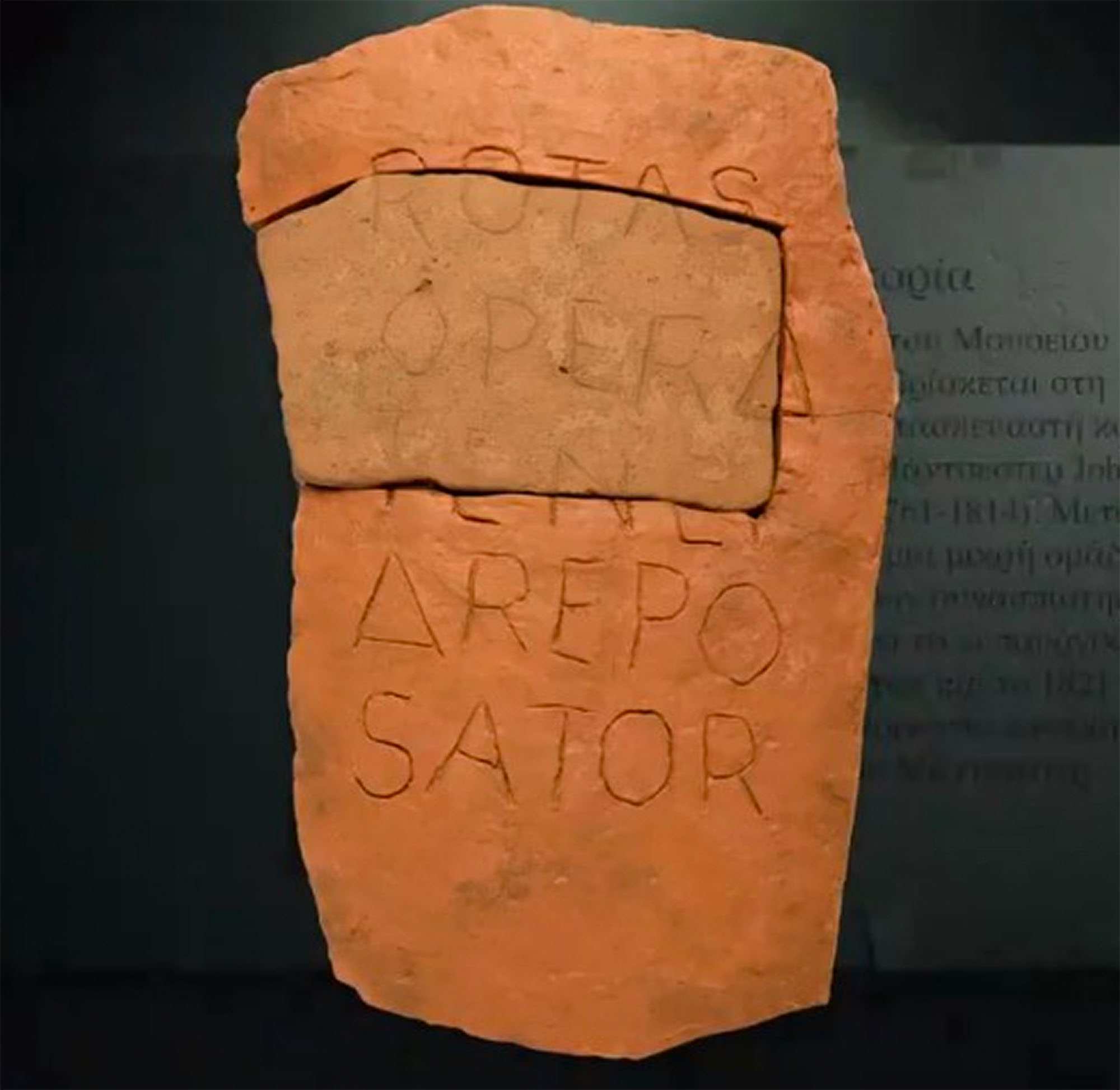
in 中文-普通话 / 国语 / Mandarin Chinese (simplified) translated by Raymond Ding
This object has been translated into 6 different languages by 6 different users
这块陶器碎片发现于1978年曼城市中心的一次考古发掘,现如今是曼城博物馆中最具标志性的馆藏文物之一。

此物源自于古罗马时代,约公元180年。上面刻着的拉丁文字是一个萨托魔方阵。文字魔方在西方有着悠久的历史,它们的特点在于对称性:以两个对角线为轴,阵中的字母是对称的。同理,第一行的内容等同于第一列的内容,第二行等同于第二列,等等。萨托魔方阵是文字魔方的一种,名字来源于第一行的文字 SATOR,也有一些版本是反过来的 ROTAS,曼城的这个魔方阵便是如此。
萨托魔方阵最早可追溯至两千余年前的庞贝古城墙壁上,后来在意大利以外的一些其他国家也发现了它们的踪迹。方阵中的五个词分别是 “ROTAS OPERA TENET AREPO SATOR”,意为 “农夫阿雷波用犁来耕作”。除此之外,这几个字母还可以重新排列成一行一列十字架形的 “PATER NOSTER”,外加两个字母 A 和 O。前者是拉丁文的圣经主祷文,直译为 “我们的父”;后者则代表了古希腊字母中的首尾两个字母阿尔法与欧米伽,因为在圣经中耶稣曾说过: “我是阿尔法,我是欧米伽”。因此萨托魔方阵在历史上有着不同于其他普通文字阵的特殊意义,而曼城的这个萨托阵也被认为是基督教传至英国北方最早的证据。

重新排列成十字架形的 “PATER NOSTER”
如今,萨托魔方阵除了历史和宗教意义以外也曾被引用到许多文学作品当中。近期美国著名导演诺兰的新作 “Tenet”(信条)的名字便是取自萨托阵中的第三排字母,而电影中反派的名字 “Sator”的来源就更明显了。
公元180年的曼城是罗马统治下的一个小镇,名字叫做 “Mamucium”,分为军队驻扎的一个堡垒和周边的居民区。我们知道那个时候有很多外国士兵都被分配到曼城来,例如日耳曼尼亚人(现称为德国),加利亚人(现称为法国),以及西班牙人。所以其实早在一千八百多年前曼城就已经是一个多元文化地区了,曼城博物馆中自然也保存了许多文物,可以让后人更深入地了解在罗马时代这里的各个民族的文化和习俗。曼城的萨托魔方阵,就是其中之一。
Do you have something you’d like to say, in your own language or English, about the object or translation? We’d like to hear what you think.
Translations are community-sourced and for anyone to participate in, however you use your language. For more information, see Community Guidelines.
17 Nov, 2023
曼城文字魔方阵, very good, thank you
11 Apr, 2023
The first known version of this square is in Pompeii, and there is a Facebook image from the Pompeii museum with a caption about it:
“It is in Pompei that this magic square, a famous Latin cryptogram that would be copied many times in the following centuries, first appears, in a room of the Casa di Paquio Proculo (House of Paquio Proculo) and on a column in the Palestra Grande (Large Gymnasium). Many theories have been put forward regarding its meaning. The square is made up of five words of five letters each (sator, arepo, tenet, opera, rotas), written one under the other in such a way that it forms a square that can be read in any direction, forming a palindrome. The 25 letters themselves, rearranged, can form the words “Pater noster” (our father, from the Catholic prayer) twice [with two extra a’s and two extra o’s, which supposedly can represent the “alpha” and “omega”, which are important in Catholic symbolism (see Wikipedia on this: https://en.wikipedia.org/wiki/Sator_Square#Paternoster_theory. It’s really hard to picture without seeing it)]. If you read the square following a zig-zag [you have to repeat the middle row in both directions], you can read “sator opera tenet – tenet opera sator”, that is, “the sower possesses [his] works” (repeated in another order because Latin doesn’t depend on the order of words as much as English does), perhaps talking about a Christian God who created the world. And finally, the word “tenet”, which crosses itself at the centre of the square can be seen to represent a hidden version of the Christian cross used by the early Christians, who might not have been able to be open about their religion, as this example comes from 79 C.E., less than 50 years after the death of Christ in the Christian religion, and a period when Christians were still persecuted for their beliefs. This hypothesis is fascinating, but the symbol of the cross wasn’t really used until much later in history, so perhaps the magic square is just a bit of wordplay that was later reinterpreted to have a Christian message…”
11 Apr, 2023
The Italian source for the text above, and a link where you can see the image:
https://www.facebook.com/pompeiisoprintendenza/photos/il-quadrato-magico-di-pompei-ovvero-il-famoso-crittogramma-in-latino-pi%C3%B9-volte-r/1597578133882732/
Il quadrato magico di Pompei, ovvero il famoso crittogramma in latino più volte riprodotto nei secoli a venire, appare per la prima volta proprio a Pompei, graffito in una stanza della Casa di Paquio Proculo e su una colonna della Palestra Grande. Sul suo significato sono state costruite molte teorie. Si tratta di cinque parole di cinque lettere ciascuna (sator arepo tenet opera rotas), scritte di seguito una sotto l’altra in modo da formare un quadrato, che possono essere lette in qualsiasi direzione formando un palindromo. Le 25 lettere, scomposte e ricomposte, formano due volte l’espressione Pater Noster. Se si legge il quadrato a serpentina, inoltre, si ha “sator opera tenet – tenet opera sator”, cioè “il seminatore possiede le opere”, ovvero è il signore del creato. E ancora, l’incrocio delle due parole tenet disegna al centro del quadrato una croce perfetta: si tratterebbe di una raffigurazione cifrata dei primi cristiani, considerando che siamo prima del 79 d.C., siamo a meno di 50 anni dalla morte di Cristo! L’ ipotesi e’ affascinante, ma considerando che il simbolo della croce e’ molto piu’ tardo, il quadrato magico e’ solo un calembour reinterpretato successivamente come messaggio cristiano….
31 Mar, 2023
Me gusta la traducción al español!
31 Mar, 2023
Muchas gracias, Yaron